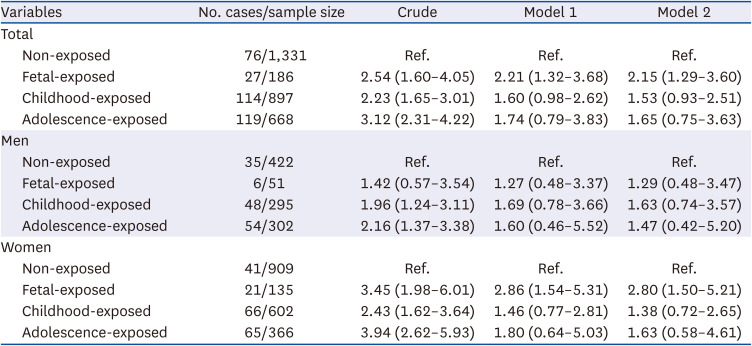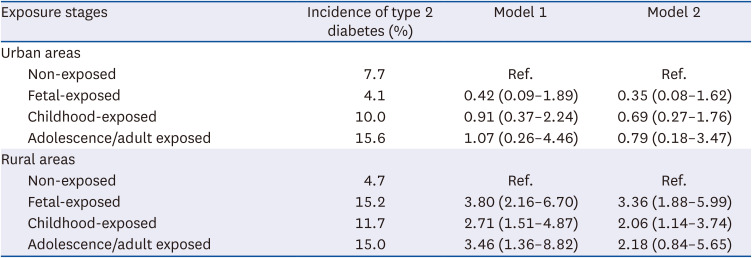1. Pan XR, Yang WY, Li GW, Liu J. National Diabetes Prevention and Control Cooperative Group. Prevalence of diabetes and its risk factors in China, 1994. Diabetes Care. 1997; 20:1664–1669. PMID:
9353605.

2. Li Y, Teng D, Shi X, Qin G, Qin Y, Quan H, Shi B, Sun H, Ba J, Chen B, et al. Prevalence of diabetes recorded in mainland China using 2018 diagnostic criteria from the American Diabetes Association: national cross sectional study. BMJ. 2020; 369:m997. PMID:
32345662.

3. Hidayat K, Du X, Shi BM, Qin LQ. Foetal and childhood exposure to famine and the risks of cardiometabolic conditions in adulthood: a systematic review and meta-analysis of observational studies. Obes Rev. 2020; 21:e12981. PMID:
32048436.

4. Liu L, Wang W, Sun J, Pang Z. Association of famine exposure during early life with the risk of type 2 diabetes in adulthood: a meta-analysis. Eur J Nutr. 2018; 57:741–749. PMID:
27999932.

5. Xin X, Yao J, Yang F, Zhang D. Famine exposure during early life and risk of hypertension in adulthood: a meta-analysis. Crit Rev Food Sci Nutr. 2017; 6:1–8.

6. Li C, Lumey LH. Exposure to the Chinese famine of 1959–61 in early life and long-term health conditions: a systematic review and meta-analysis. Int J Epidemiol. 2017; 46:1157–1170. PMID:
28338900.

7. Ning F, Ren J, Song X, Zhang D, Liu L, Zhang L, Sun J, Zhang D, Pang Z, Qiao Q, et al. Qiao Q on behalf of Qingdao Diabetes Prevention Program(2019) Famine exposure in early life and risk of metabolic syndrome in adulthood: Comparisons of different metabolic syndrome definitions. J Diabetes Res. 2019; 2019:7954856. PMID:
31886286.
8. Ning F, Zhang D, Xue B, Zhang L, Zhang J, Zhu Z, Zhang D, Gao R, Pang Z, Qiao Q, et al. Synergistic effects of depression and obesity on type 2 diabetes incidence in Chinese adults. J Diabetes. 2020; 12:142–150. PMID:
31287240.

9. Andersson T, Alfredsson L, Källberg H, Zdravkovic S, Ahlbom A. Calculating measures of biological interaction. Eur J Epidemiol. 2005; 20:575–579. PMID:
16119429.

10. Li Y, Han H, Chen S, Lu Y, Zhu L, Wen W, Cui L, Wu S. Effects related to experiences of famine during early life on diabetes mellitus and impaired fasting glucose during adulthood. Zhonghua Liu Xing Bing Xue Za Zhi. 2014; 35:852–855. PMID:
25294081.
11. Bercovich E, Keinan-Boker L, Shasha SM. Long-term health effects in adults born during the Holocaust. Isr Med Assoc J. 2014; 16:203–207. PMID:
24834754.
12. Meng R, Lv J, Yu C, Guo Y, Bian Z, Yang L, Chen Y, Zhang H, Chen X, Chen J, et al. Prenatal famine exposure, adulthood obesity patterns and risk of type 2 diabetes. Int J Epidemiol. 2018; 47:399–408. PMID:
29161448.

13. van Abeelen AF, Elias SG, Bossuyt PM, Grobbee DE, van der Schouw YT, Roseboom TJ, Uiterwaal CS. Famine exposure in the young and the risk of type 2 diabetes in adulthood. Diabetes. 2012; 61:2255–2260. PMID:
22648386.

14. Lumey LH, Khalangot MD, Vaiserman AM. Association between type 2 diabetes and prenatal exposure to the Ukraine famine of 1932–33: a retrospective cohort study. Lancet Diabetes Endocrinol. 2015; 3:787–794. PMID:
26342852.

15. Zhou J, Zhang L, Xuan P, Fan Y, Yang L, Hu C, Bo Q, Wang G, Sheng J, Wang S. The relationship between famine exposure during early life and body mass index in adulthood: a systematic review and meta-analysis. PLoS One. 2018; 13:e0192212. PMID:
29408921.

16. Singh GM, Danaei G, Farzadfar F, Stevens GA, Woodward M, Wormser D, Kaptoge S, Whitlock G, Qiao Q, Lewington S, et al. The age-specific quantitative effects of metabolic risk factors on cardiovascular diseases and diabetes: a pooled analysis. PLoS One. 2013; 8:e65174. PMID:
23935815.

17. Shepherd PR, Crowther NJ, Desai M, Hales CN, Ozanne SE. Altered adipocyte properties in the offspring of protein malnourished rats. Br J Nutr. 1997; 78:121–129. PMID:
9292765.

18. Wang Z, Zou Z, Yang Z, Dong Y, Song J, Dong B, Ma J, Arnold L. The association between fetal-stage exposure to the China famine and risk of diabetes mellitus in adulthood: results from the China health and retirement longitudinal study. BMC Public Health. 2018; 18:1205. PMID:
30367620.

19. Kline J, Stein Z, Susser M. Conception to Birth: Epidemiology of Prenatal Development. New York (NY): Oxford University Press;1989.
20. Hales CN, Barker DJ. The thrifty phenotype hypothesis. Br Med Bull. 2001; 60:5–20. PMID:
11809615.

21. Tobi EW, Lumey LH, Talens RP, Kremer D, Putter H, Stein AD, Slagboom PE, Heijmans BT. DNA methylation differences after exposure to prenatal famine are common and timing- and sex-specific. Hum Mol Genet. 2009; 18:4046–4053. PMID:
19656776.

22. Tobi EW, Slieker RC, Luijk R, Dekkers KF, Stein AD, Xu KM, Slagboom PE, van Zwet EW, Lumey LH, Heijmans BT, et al. DNA methylation as a mediator of the association between prenatal adversity and risk factors for metabolic disease in adulthood. Sci Adv. 2018; 4:eaao4364. PMID:
29399631.









 PDF
PDF Citation
Citation Print
Print



 XML Download
XML Download